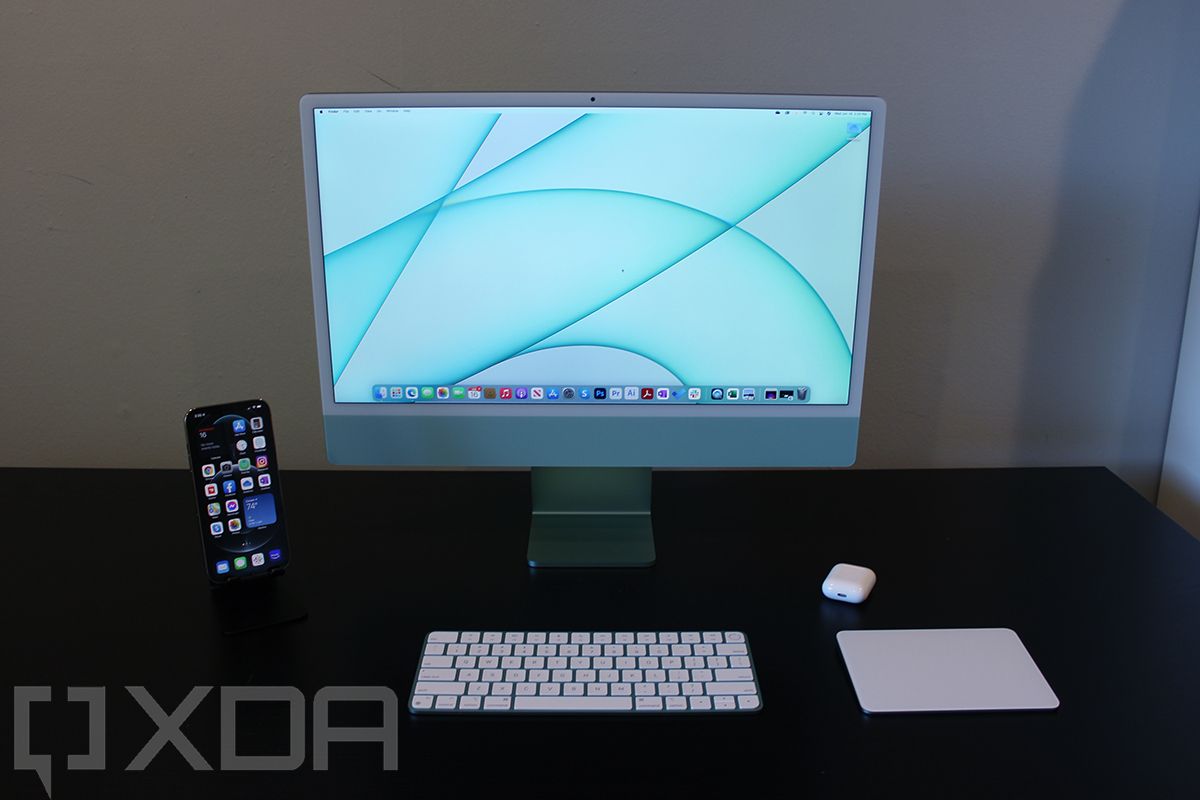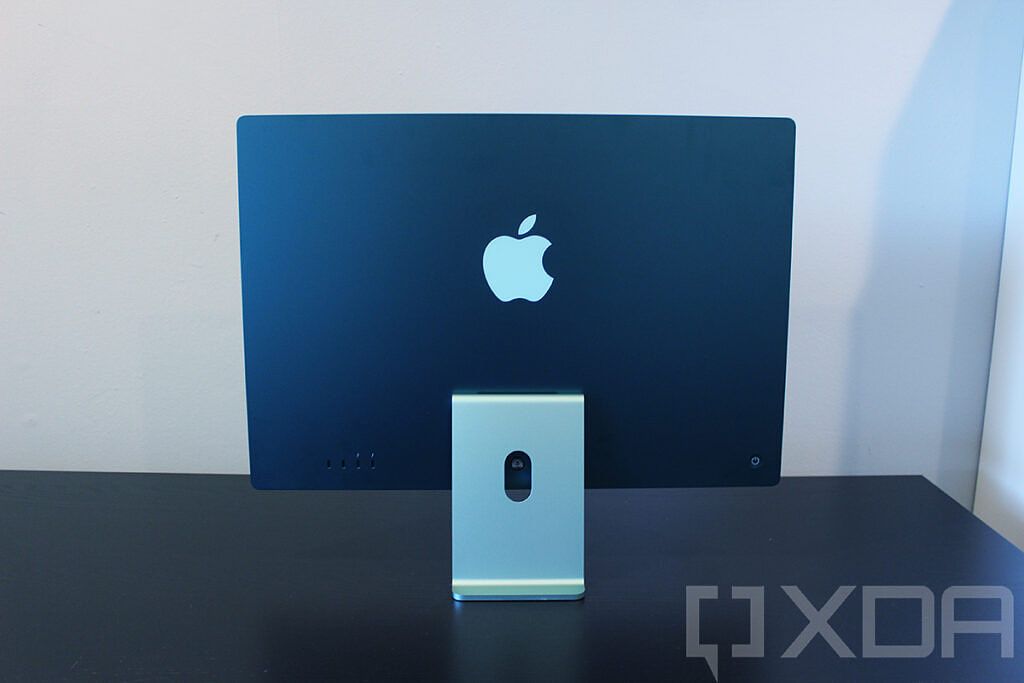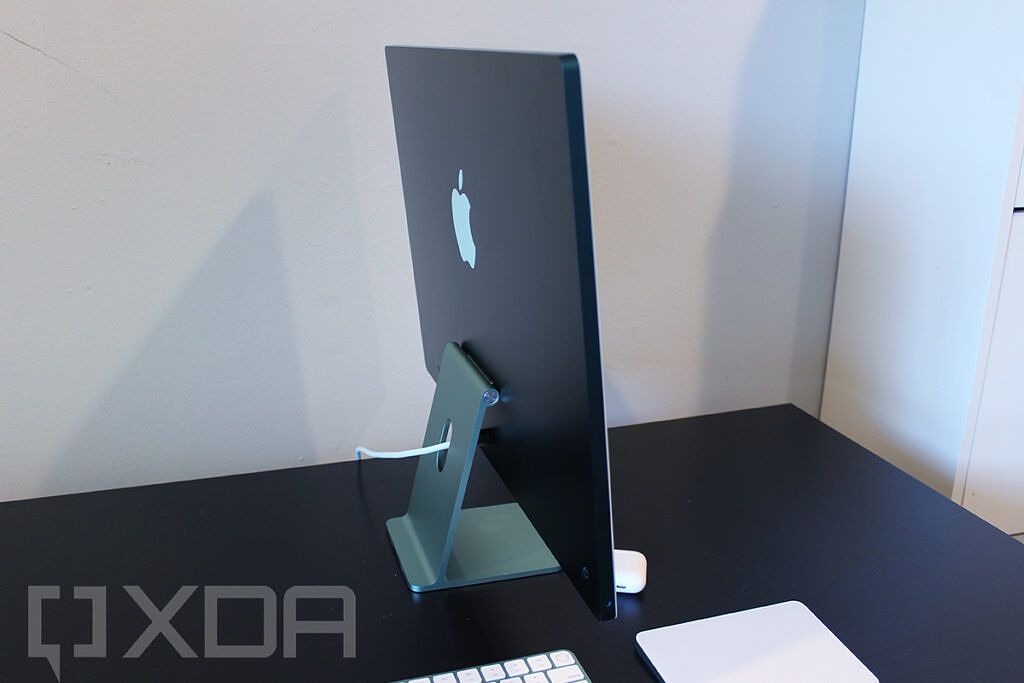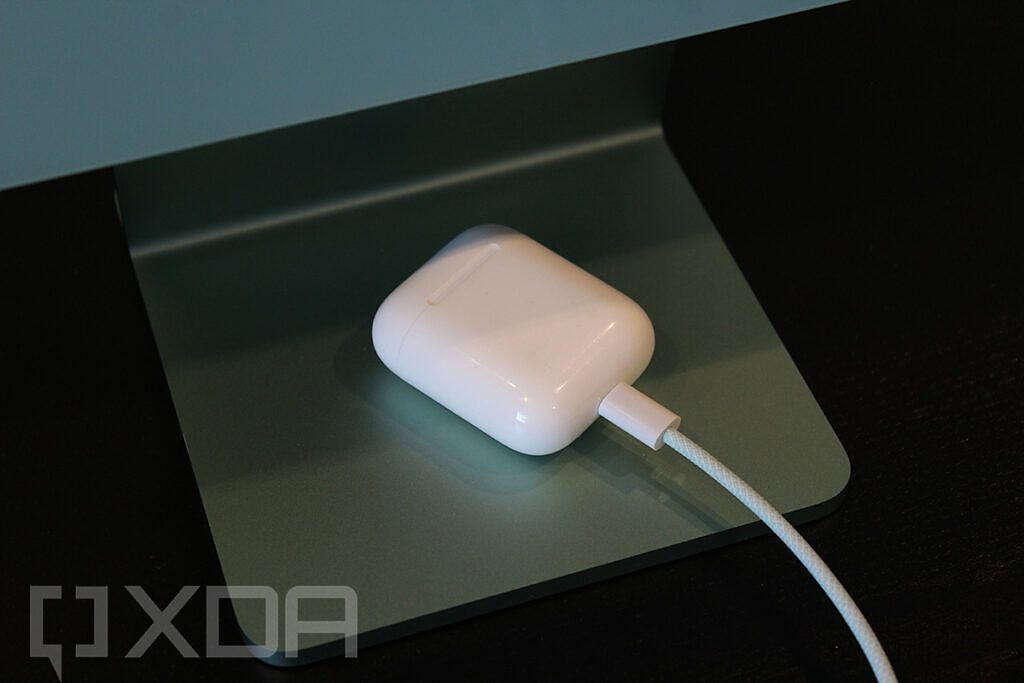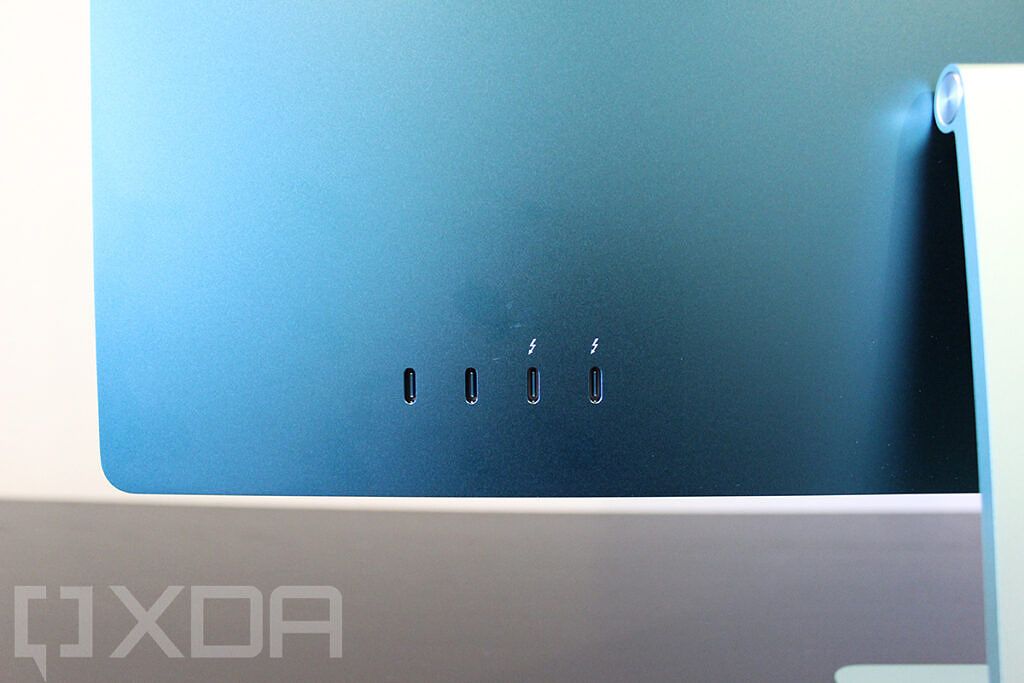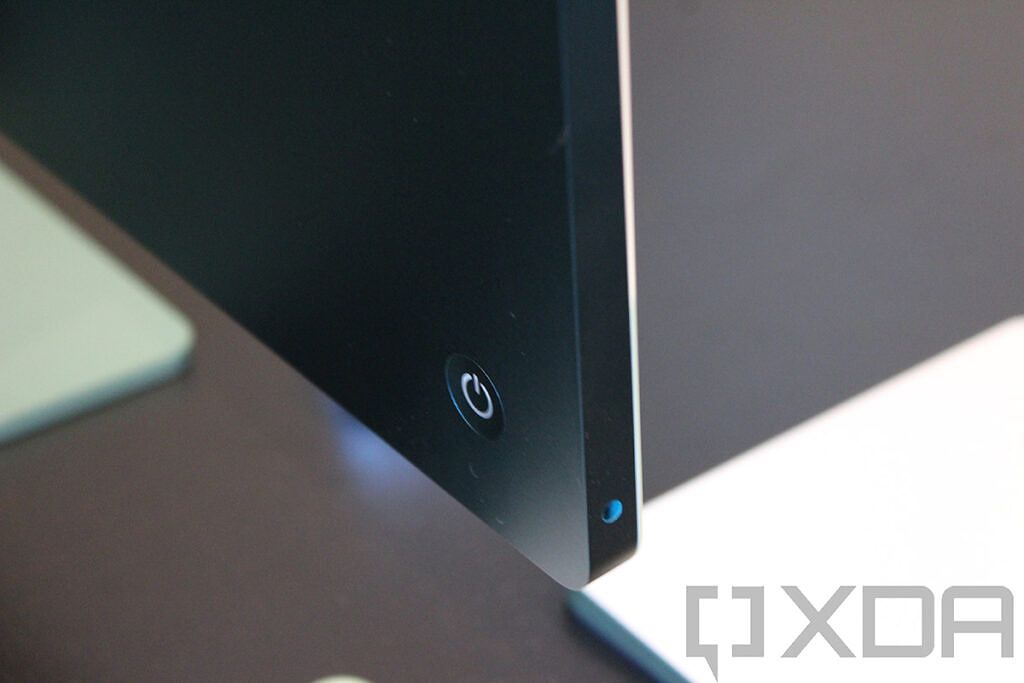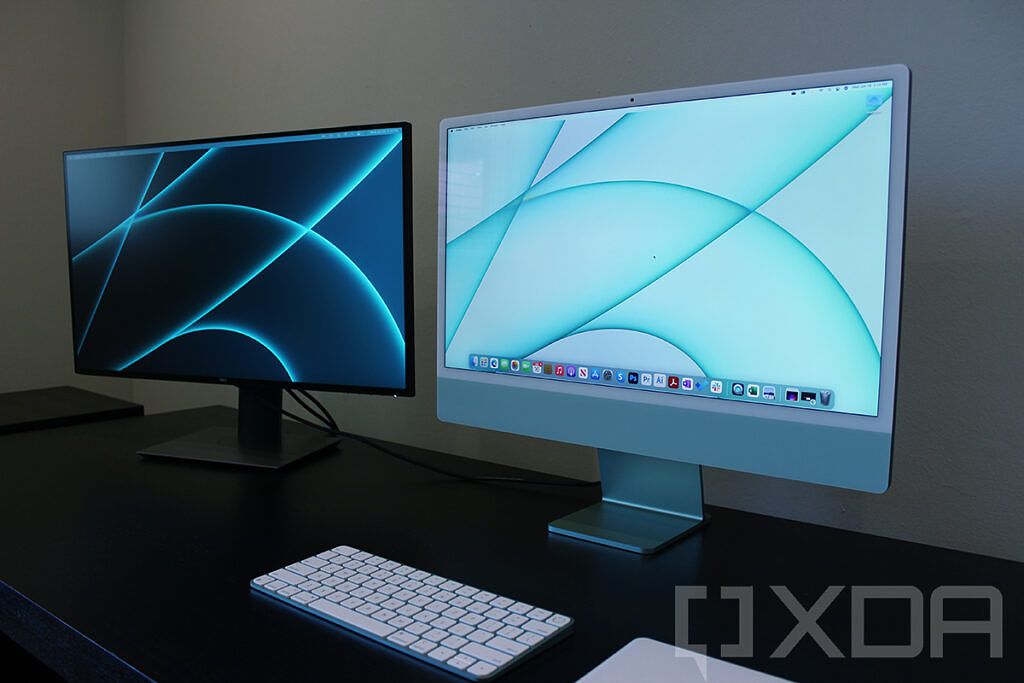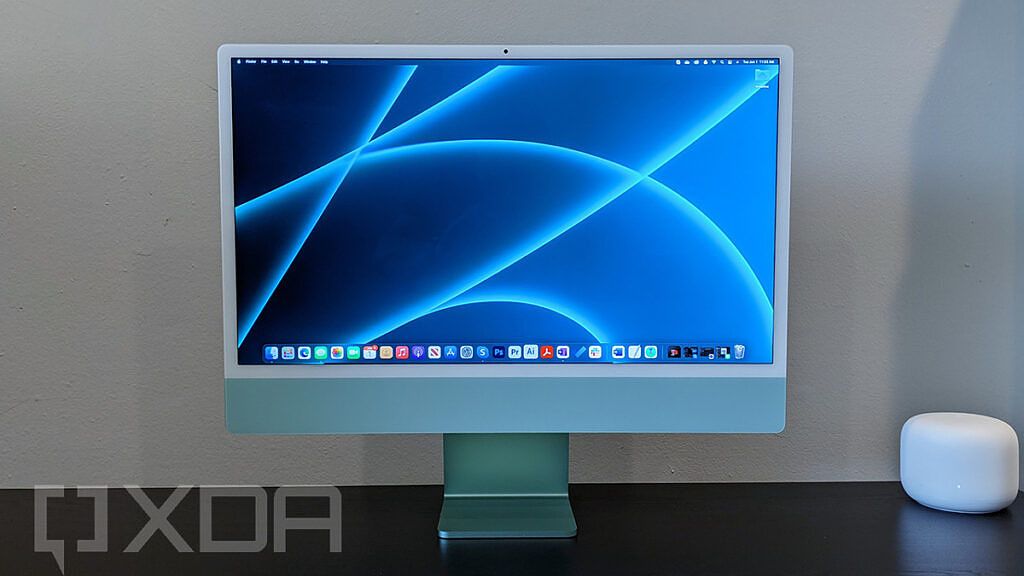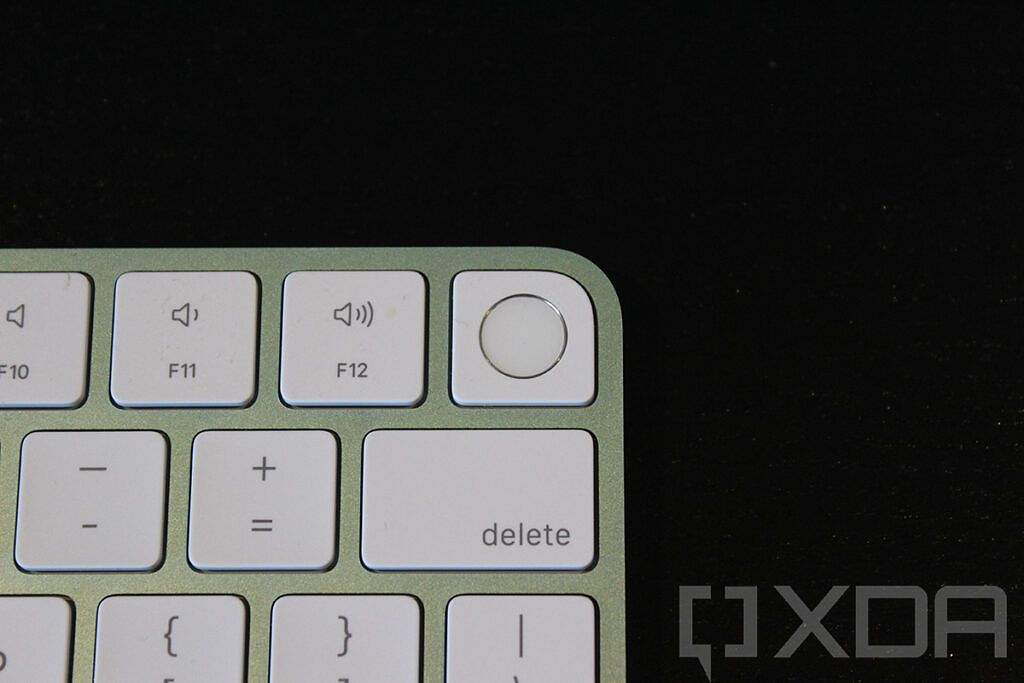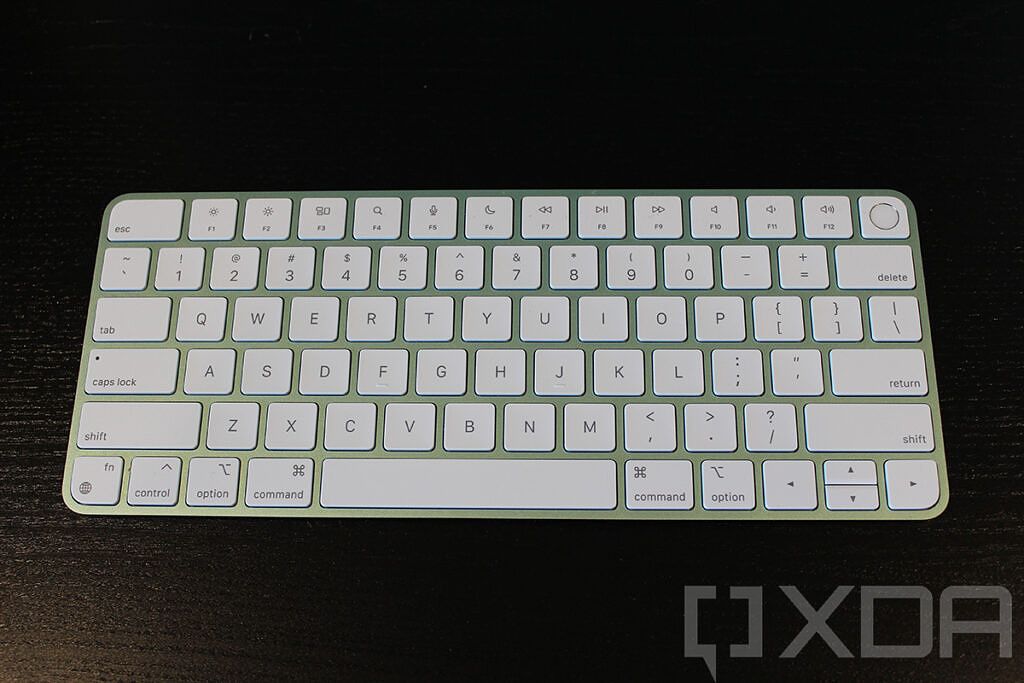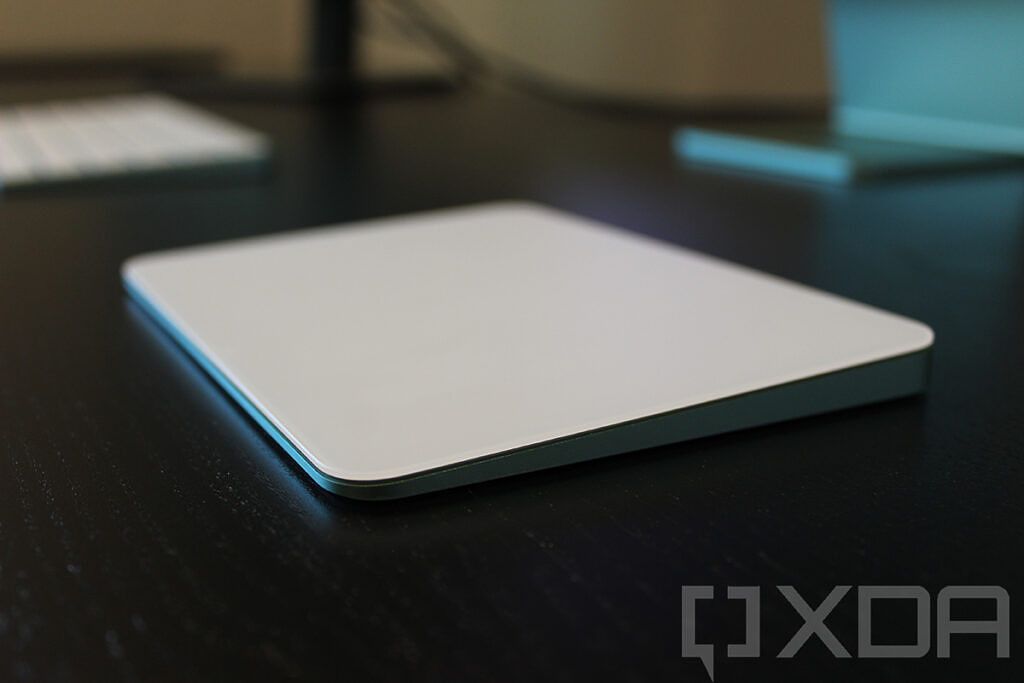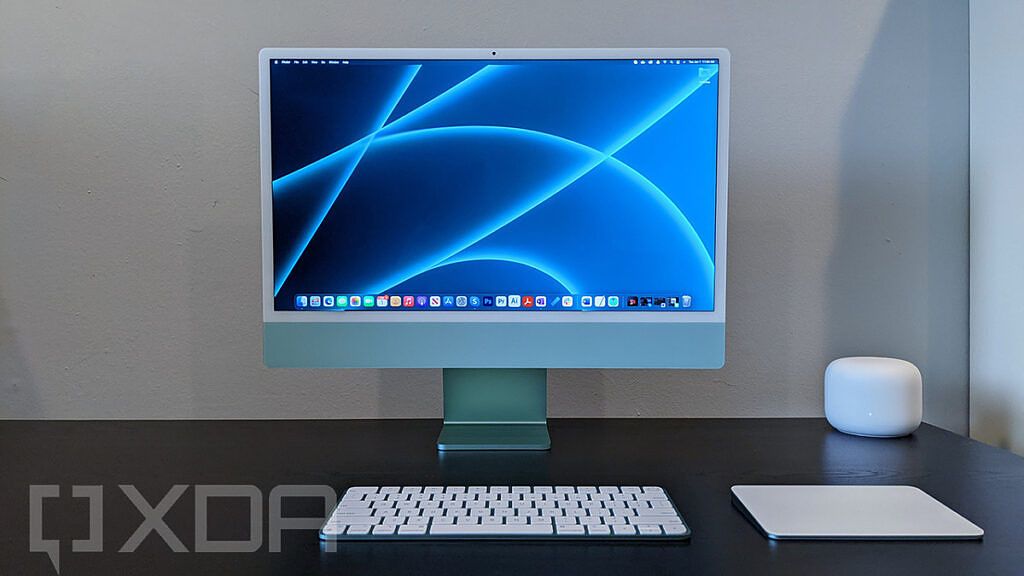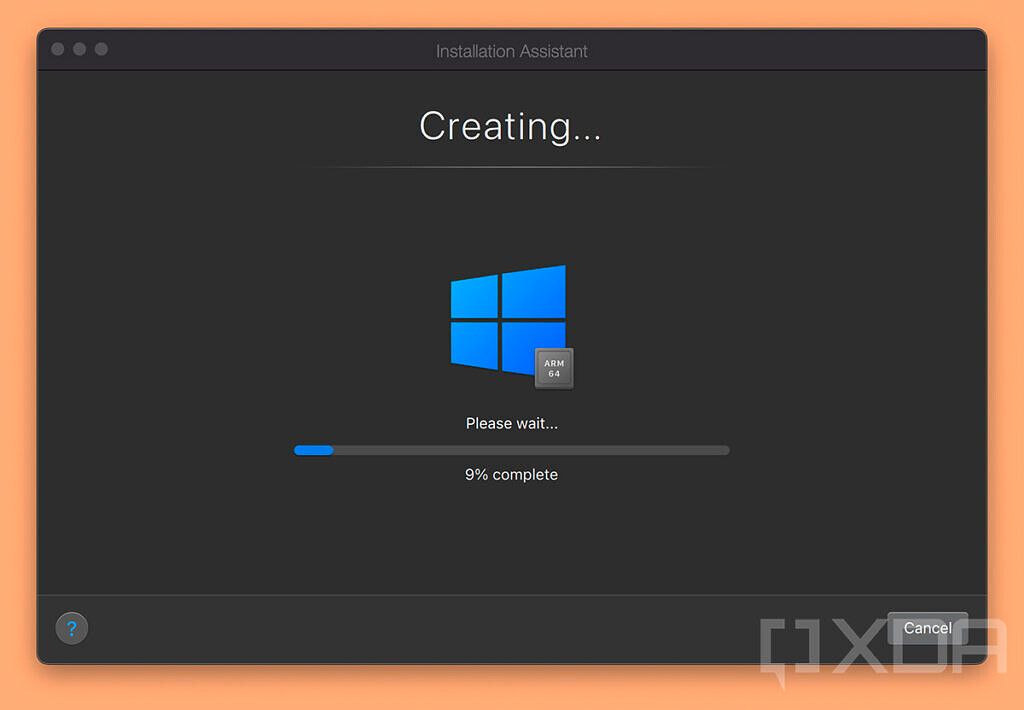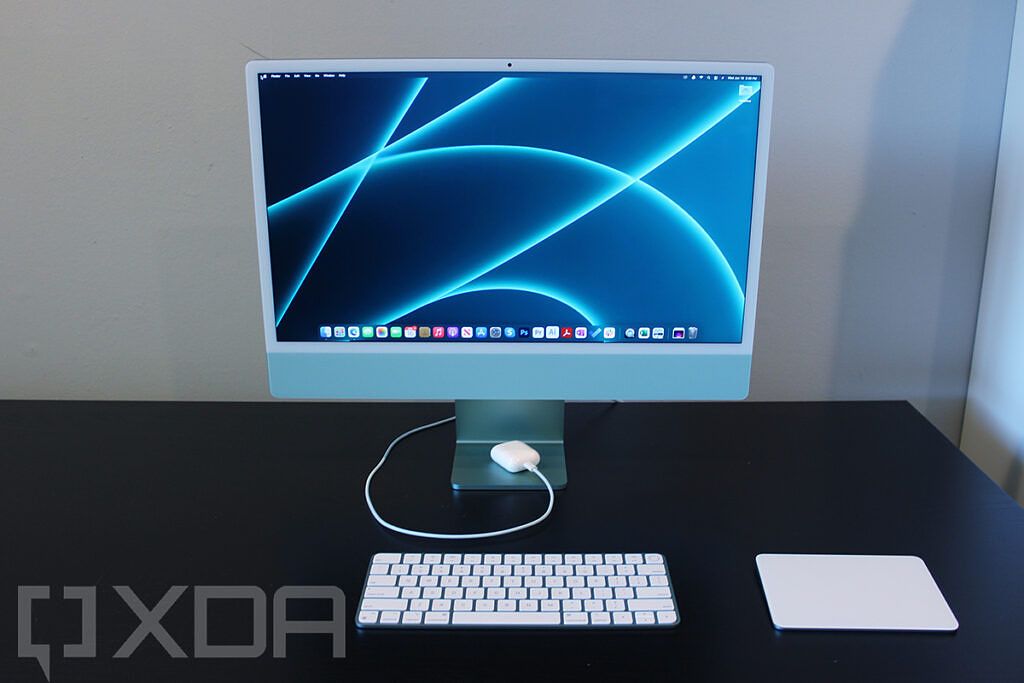Quick Links
Imagine an 11-inch tablet that's 5.9mm thick that has the power of a laptop. Imagine an all-in-one PC with a screen that's 11.5mm thick and has no external base with the internal components. Imagine an aluminum laptop that weighs 2.8 pounds and has more power than a lot of gaming PCs. Now imagine that all of these things, from the 11-inch tablet to the all-in-one desktop PC, have the same processor. That's the world that we're living in right now with Apple's M1 chip. It's insane.
With its range of Apple Silicon products — the 13-inch MacBook Pro, MacBook Air, and Mac mini — Apple pretty much swapped out the internals for its new ARM chips. When it did the 24-inch iMac, it redesigned the product, showing what you can do with a more efficient ARM chipset.
iMac 24" (2021): Specifications
|
CPU |
Apple M1 |
|---|---|
|
GPU |
8-core GPU |
|
Display |
24-inch 4.5k Retina display, 4,480x2,520, 218ppi, 500 nits |
|
Body |
547x461x58mm (21.5x18.1x5.8in), 4.487kg (9.88lbs) |
|
Storage |
256GB SSD |
|
RAM |
16GB |
|
Camera |
1080p FaceTime HD camera with M1 image signal processor |
|
Audio |
|
|
Ports |
|
|
Connectivity |
|
|
Colors |
Blue, Green, Pink, Silver, Yellow, Orange, Purple |
|
Price |
$1,699 |
About this review: XDA purchased a 24-inch iMac at retail. Apple did not have any input over the content of this review.
Design: The 24-inch iMac is the most beautiful all-in-one on the market
Personally, I think that the new 24-inch iMac is the most beautiful all-in-one PC on the market. I don't say that about a lot of Apple products. For example, no MacBook would be in my top five most beautiful laptops by any means. And yes, part of the reason that the design of this is so good is that so few OEMs are putting real effort into all-in-one PCs.
There are a few layers to this. First of all, the new 24" iMac comes in seven gorgeous colors. I went with green, although frankly, you should just go to your local Apple Store and pick out your favorite color. The colors on the back are bold, while they're accented with more subtle shades of the same color, such as the lighter shade of green that I see on the chin, the base, and the accessories. There's also a mirrored green Apple logo on the back, which makes for a nice touch.
Giving people a choice of colors is something that other OEMs simply aren't doing. In fact, with six beautiful colors, you might wonder why Apple kept Silver around. You'd be surprised how popular the Silver iMac is still going to be. HP killed off Natural Silver on its Spectre x360 lineup one year and had to bring it back by popular demand the next year. Now, HP has three colors for its flagship product, and honestly, I can't really think of any laptops that have more color options than that, let alone desktops.
The other thing that makes the new 2021 iMac beautiful is the form factor. Apple said that it wants the computer to disappear into the background. That's why the screen on the 24" iMac is just 11.5mm thin. That's a full millimeter thinner than Microsoft's Surface Studio 2. To make it even better, all of the guts of the Surface Studio 2 are in the base; that's not the case here. Using an ARM processor, Apple could shrink down the size of the motherboard in a way that really can't be done with an Intel desktop processor.
There's a metal base that's attached to the 2021 iMac, and it has a hinge that lets you adjust the angle of the PC. This is all you can adjust, though. You can't adjust the height or anything like that. This feels like an odd sacrifice to make, and it feels like form over function.
The color of the metal base is matched in the accessories. The iMac comes with a Magic Keyboard with Touch ID and Magic Mouse, although that's customizable. You can choose a Magic Trackpad or a Magic Keyboard with Touch ID with Numeric Keypad. Sadly, Apple doesn't sell these separately at the moment, so choose wisely. We've reviewed these accessories separately in case you're interested.
Other color-matched items include a braided USB-C to Lightning cable, and the power cable. Note that the magnetic power cable also can't be purchased separately at the moment. One thing that I love about the power cable is that it has an Ethernet port in it. It's one less thing that you'd have to plug into the back of your PC, which is always better for cable management.
The ports that are on the back of the 24" iMac are four USB Type-C ports, two of which are Thunderbolt and two of which aren't. Note that if you buy the base iMac model, you're just getting the two Thunderbolt ports. That means that you'll probably need to invest in some docks and dongles.
I mainly used one of the Thunderbolt ports to connect my iMac to an external 4K monitor. Note that while Thunderbolt typically supports two 4K monitors, that's not the case here. As with all M1-powered Apple PCs except for the Mac mini, you can only connect the 24 inch iMac to a single external monitor, which can be up to 6K resolution. It's not an issue of power, because you can't even connect multiple lower resolution screens. Rather, this is a chipset limitation. While I found this to be a real pain point with the MacBook Pro, it doesn't bother me so much with the iMac, as it already has one big screen.
As for using the other three ports, you'll probably want to keep at least one USB Type-C to USB Type-A dongle on-hand. I use an HP OMEN Outpost mousepad which connects via USB Type-C and has a wireless charging pad built into it, but it also adds a USB Type-A port in case I need one. The Magic Keyboard with Touch ID and Magic Mouse both connect to the iMac via Bluetooth, so that's a non-issue. The point is that while it's natural to be skeptical about not having USB Type-A, I didn't find it to be an issue.
Finally, there's a 3.5mm audio jack at the bottom on the last side of the screen. Confession: I kind of wish it wasn't there. It's not in a practical place for headphones, as a wire has to stretch across my desk. Being that Apple has been at the forefront of pushing people toward Bluetooth audio, I wouldn't have minded seeing the headphone jack killed off on the 24" iMac like it was on the iPhone.
Display: The 24-inch iMac has a gorgeous 4.5K Retina screen
The 24-inch iMac has a 4,480x2,520 resolution Retina display. Retina, according to Apple, means that from an average viewing distance, you can't see any pixelation, and this beautiful screen on the 24-inch iMac does not disappoint in that regard. It's gorgeous, although you can definitely see the pixelation if you look close since it's 218ppi. Of course, there's more to the display than the high resolution.
In my testing, it supports 100% sRGB, 87% NTSC, 89% Adobe RGB, and 100% P3. According to Apple, it supports over a billion colors, which isn't actually surprising. Indeed, the 2021 iMac has a beautiful display not just to look at, but to work on.
For me, 24 inches is a little bit small. And here's where it gets a bit weird. The bezels on the 24-inch iMac are way too big. This machine sits next to a 27-inch 4K monitor on my desk and it feels like it's actually bigger — and that's because the chassis is actually much bigger.
Around the frame of the iMac, there's a white bezel, and yes, I know this has been heavily criticized. We've been down this road with the iPhone already. In the pre-iPhone X days, any iPhone aside from the Space Gray model had white bezels, and it was a dark time in history. That changed with the iPhone X, which had a silver model with black bezels. It would seem that that change wasn't because Apple learned a lesson.
I don't notice it, though. Sure, I'd prefer a black bezel, but the lighter look feels like it fits the theme of the PC. The massive chin below the iMac's screen is a lighter shade of green, and there are some questions here, such as why it doesn't use the bolder and prettier shade of green found on the back, or why there's such a big chin to begin with.
But now we're talking design. Whether you love or hate the white bezel, that's entirely your call to make.
But one thing that's objectively great is found in the top bezel of the 24-inch iMac: the 1080p webcam. I've heard people mock Apple for finally using an FHD webcam, but to be honest, the whole industry is lagging on this. Considering how many people are working from home, a better webcam is more important to have than ever. I've been told by several OEMs that it just takes a long time to get it into the product, as all of the specs are decided so far in advance. Hopefully, we'll see more FHD webcams moving forward.
There's a lot going on in the giant chin, however. Apple is offering what it's calling a high-fidelity six-speaker system with force-canceling woofers in the iMac, and it sounds awesome. It also supports spatial audio when playing Dolby Atmos content. I really didn't find myself having to use headphones, although I did if other people were home. While on a call, I could use the iMac's built-in three-mic array and those built-in speakers, and everything worked fine. It also gets nice and loud if you're listening to music or watching a show.
Magic Keyboard with Touch ID and Magic Trackpad: Yup, they match the color
First of all, if you're interested in these products, I again encourage you to read Ben Sin's in-depth review of the Magic Keyboard with Touch ID and the Magic Mouse.
The keyboard and trackpad that come with the new iMac are fine. When it comes to quality, there's legitimately nothing new here. It's the same keyboard and trackpad that Apple has been offering for ages. The changes have nothing to do with quality, and to be honest, while it's fine, it's not one of my favorite keyboards. There are plenty of better ones out there.
Here's what's changed. There's now a Touch ID button in the top-right corner. You can use it when unlocking the iMac and at times when it asks for a password. I find it somewhat frustrating, though, since you can't use it all the time. You can't use Touch ID when the iMac first boots up, similar to when you first boot up an iPhone. It's just annoying, since every other PC that uses a fingerprint sensor lets you use it more often. Touch ID also only works with Apple Silicon Macs, since it requires the secure enclave.
The other change is that the Magic Keyboard is color-matched. Indeed, I've been typing on this lovely green keyboard with white keys since I've had the 24-inch iMac, and it's quite pretty. The Magic Trackpad is also green around the sides, while it's white on top. It's the same lighter shade of green seen in the iMac's base.
Both connect via a Lightning cable if you need to, or you can just charge them that way. Indeed, it's nice to have that matching green USB-C to Lightning cable that comes in the box. It's just a shame that Apple doesn't actually sell any of this stuff separately.
When you order your 24" iMac, you get some choices. You can get a Magic Keyboard with Touch ID or you can get the Magic Keyboard with Touch ID and Numeric Keypad. You can also choose between the Magic Mouse and Magic Trackpad when ordering your unit. And again, make sure you choose wisely, because as of now, that choice is permanent.
Performance: The 24-inch iMac isn't a pro machine, but it gets the job done
When I reviewed the M1-powered MacBook Pro, it really impressed me. If you compared it to a similar laptop on the Windows side, the Mac's benchmark scores blew it away. Performance in most areas did too. I performed tests like running a video through Premiere Pro and seeing how long it took to compile; the M1 smoked anything from Intel's U-series, although it didn't quite do as well when it came to dedicated graphics and a 45W Intel CPU.
That performance is still there, but the landscape changes because you have to look across the board at desktops instead of laptops. I also don't have any current-generation Intel-powered all-in-one PCs to put this up against. Still, that's okay because the use cases vary so much across the board.
The 24-inch iMac is positioned more as the consumer model. It's the MacBook Air of iMacs. The MacBook Pro equivalent is going to be the 27-inch iMac, and when that gets refreshed, don't be surprised if it doesn't come in the same pretty colors. I say this to set expectations that this is more along the lines of a productivity machine instead of the kind of machine that you're doing 3D modeling on.
That said, you're not going to feel like you're missing out here. At no point did I feel like the 24-inch iMac was sluggish because it has a processor that's also found in an 11-inch tablet. This doesn't just feel like it's passable; it feels like a great desktop PC. I edited all of my images in Photoshop and edited 4K 60fps videos in Premiere Pro.
I recorded a quick 20-second 4K 60fps video with my iPhone 12 Pro Max, and then I imported it and exported it with Adobe Premiere Pro. The results weren't quite what I expected.
|
Model |
Specs |
Rendering time (seconds) |
|---|---|---|
|
24-inch iMac |
Apple M1, 16GB RAM |
27.41 |
|
Lenovo Legion 5 Pro |
AMD Ryzen 7 5800H, NVIDIA GeForce RTX 3070 8GB |
22.94 |
|
Lenovo ThinkPad X1 Yoga |
Intel Core i7-1185G7 |
23.66 |
Let's move onto Geekbench scores. Note that there's a severe lack of benchmarking applications that I can actually use here, and Geekbench only tests the CPU. I added in the HP Z2 SFF G8 for benchmarks, since that's a desktop, but it's more along the lines of the "pro" machine I mentioned earlier.
|
Model |
Specs |
Single / Multi-core |
|---|---|---|
|
24-inch iMac |
Apple M1, 16GB RAM |
1,740 / 7,676 |
|
Lenovo Legion 5 Pro |
AMD Ryzen 7 5800H, NVIDIA GeForce RTX 3070 8GB, 16GB RAM |
1,475 / 7,377 |
|
Lenovo ThinkPad X1 Yoga |
Intel Core i7-1185G7, 16GB RAM |
1,592 / 5,518 |
|
HP Z2 SFF G8 |
Core i7-11700K, Quadro RTX 3000, 32GB RAM |
1,714 / 10,175 |
This pretty much adds up to the fact that the Apple M1 is not just good, it's really good. It's not the best you can get, though, nor should it be. There's a reason that the 13-inch MacBook Pro still uses Intel chips in the higher-end models: The actual "pro" version of Apple Silicon isn't here yet.
Probably the biggest benefits that you're getting from the Apple M1 in the 24-inch iMac are in the design. This thing comes in such a slim package, which is something that wasn't possible before.
Native apps on Apple Silicon
With the move to the ARM-based M1 chip, not all apps have been recompiled to run natively just yet. Still, that's fine. Apple's Rosetta is quite good, and I didn't notice any real lag on my ARM-based iMac like I would when using an ARM-based Windows PC.
Even with Rosetta as good as it is, Apple has done a much better job at getting developers to build native apps than Microsoft has. Starting with core apps, Microsoft Edge and Google Chrome both run natively, as does Office. Sadly, Microsoft OneDrive still requires Rosetta.
Adobe Creative Cloud is a bit of a mixed bag. Photoshop runs natively now, although things like Premiere Pro and Illustrator are still in beta. I've talked to people at Adobe about this, and I've heard it just takes time. These are big apps, and more importantly, they're old apps with a lot of legacy code. I ran the Premiere Pro and Illustrator betas and didn't have an issue though.
Zoom is native, and honestly, there are some other apps that I forget about. Once you install them and start using them for a while, you actually won't be able to tell the difference.
One thing that still gets to me is that macOS asks for permission for everything. Just a warning: the first time you share your screen in a meeting, you'll have to give permission, and you'll have to restart the app. That means that you're going to have to leave the meeting and come back just to share your iMac's screen.
Running Windows on the Apple M1
I wrote up a full guide on running Windows on an Apple Silicon Mac like this one. The short version of it is that you can run Windows using virtualization software like Parallels, but Boot Camp is gone. One thing that's nice is that Apple finally got rid of the shortcut. You used to actually be able to launch it, and then it would tell you that it doesn't work on Apple Silicon.
The M1 uses the ARM instruction set, which means that you need to use the ARM64 version of Windows 10. This is important to note. In the past, you could buy an Intel-powered iMac, dual boot Windows and macOS, and use the Windows partition for playing games like the upcoming Forza Horizon 5 and Halo Infinite.
You can't do that anymore. Windows is going to support 64-bit emulation at some point, and in fact, Microsoft only offers preview builds of the OS as ARM64 images. Still, don't plan on any AAA gaming on the 2021 iMac unless you plan on going the cloud gaming route.
Apple Silicon also doesn't support 32-bit ARM apps. That means that some native pre-installed apps on Windows won't work. Microsoft has improved this to some extent, giving users a way to access things like the Microsoft Store and other important apps.
Honestly, with the level of support that Windows on ARM gets, I'm just not sure that you could get anything by running Windows that you can't get from macOS. And if you need more, you probably still need an Intel machine.
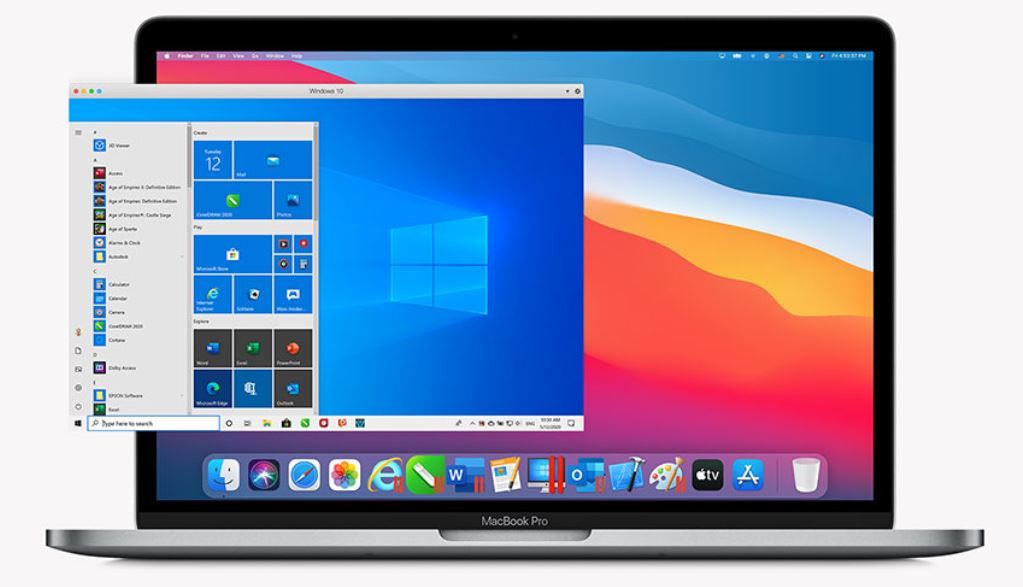
Parallels Desktop
Parallels Desktop is virtualization software for running Windows, Linux, or anything else
Conclusion: Should you buy the 24-inch iMac?
The 24-inch iMac is a computer that's so easy to fall in love with. It's just so beautifully designed. It's thoughtfully designed too, with a matching keyboard, trackpad, and even power and Lightning cables.
My biggest complaint with the iMac is probably that when I'm using a computer, I'm looking at the front of it. The bold and beautiful shade of green would look amazing if my wall had eyes, but it doesn't.
While I love the new iMac, I wouldn't use this computer forever. I'd also bet that this is as far as Apple will push the M1 before it rolls out something more powerful. If you're looking to do heavy tasks that you'd look for "pro" branding on, this really isn't the machine for you. This is the every-person iMac. It's the family computer that can be showcased on a desk in the living room or in the home office.
That being said, the engineering is wonderful. That goes right down to the M1 itself. Not even Qualcomm has the chops to make custom processors like this just yet, although that's coming. And when Apple started out with Apple Silicon, it didn't even redesign the products. It went all-in on performance, letting skeptics know that there won't be compromises here.
Now that performance is settled, we're going to start seeing some product redesigns like this. Macs can get thinner, lighter, and smaller. With the ARM architecture, the chip is smaller, the motherboard is smaller, and you can just do more with a small space.
If you're looking for an all-in-one PC for general purpose tasks, I really can't think of anything better than the 24" iMac.
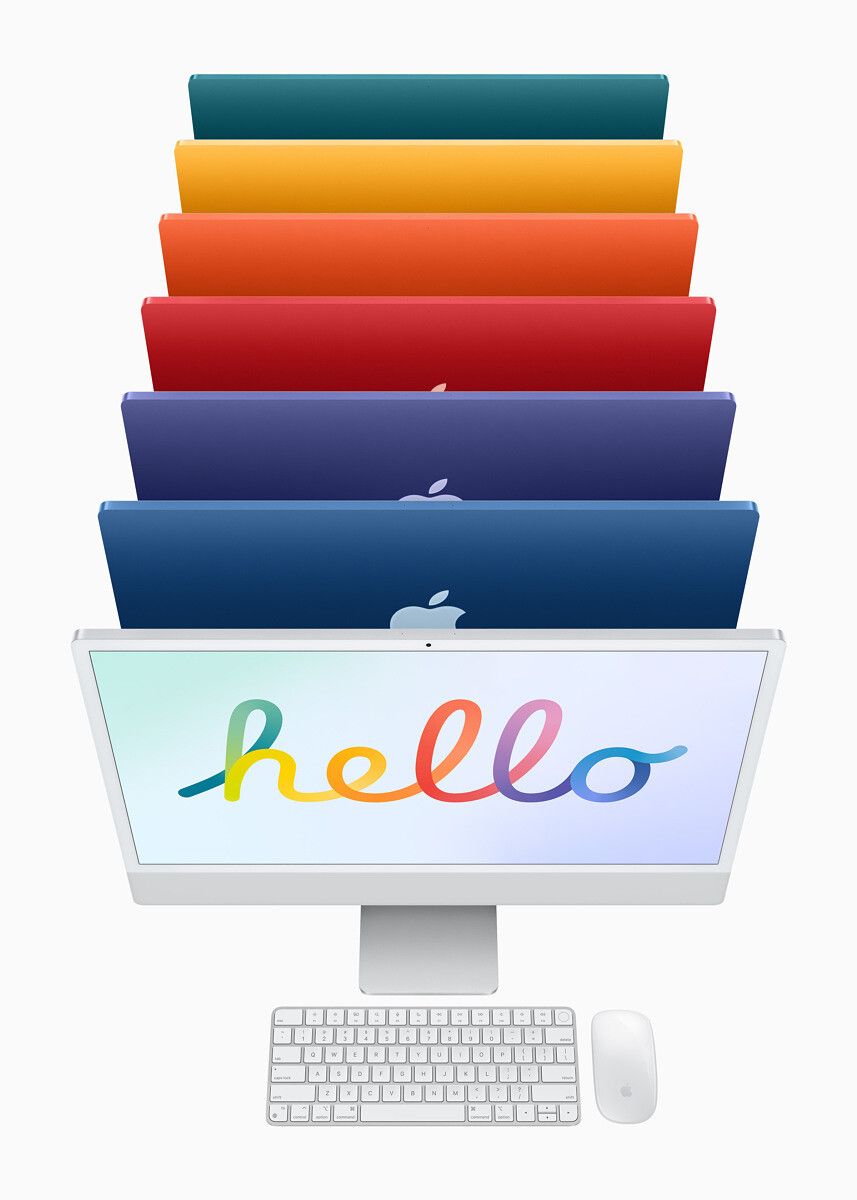
Apple iMac (2021)
Apple's newest iMac is for the every-day user, coming in pretty colors and including Apple Silicon.

